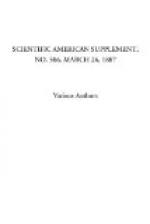properties of the crystal. We have just seen
that in clinorhombic crystals the principal absorption
directions of certain bands were completely different
from the axis of optical elasticity of the crystal
for the corresponding radiations. If we examine
this anomaly, we perceive that the crystals manifesting
these effects are complex bodies, formed of various
matters, one, or sometimes several, of which absorb
light and give each different absorption bands.
Now, M. De Senarmont has shown that the geometric isomorphism
of certain substances does not necessarily involve
identity of optical properties, and in particular
in the directions of the axes of optical elasticity
in relation to the geometric directions of the crystal.
In a crystal containing a mixture of isomorphous substances,
each substance brings its own influence, which may
be made to predominate in turn according to the proportions
of the mixture. We may, therefore, admit that
the molecules of each substance enter into the crystal
retaining all the optical properties which they would
have if each crystallized separately. The principal
directions of optical elasticity are given by the resultant
of the actions which each of the component substances
exerts on the propagation of light, while the absorption
of a given region of the spectrum is due to a single
one of these substances, and may have for its directions
of symmetry the directions which it would have in
the absorbing molecule supposing it isolated.
It may happen that these directions do not coincide
with the axes of optical elasticity of the compound
crystal. If such is the cause of the anomaly
of certain principal directions of absorption, the
bands which present these anomalies must belong to
substances different from those which yield bands
having other principal directions of absorption.
If so, we are in possession of a novel method of spectral
analysis, which permits us to distinguish in certain
crystals bands belonging to different matters, isomorphous,
but not having the same optical properties. Two
bands appearing in a crystal with common characters,
but presenting in another crystal characters essentially
different, must also be ascribed to two different
bodies.
* * * *
*
[Continued from SUPPLEMENT, No. 585, page 9345.]
HISTORY OF THE WORLD’S POSTAL SERVICE.
It is commonly believed in Europe that the mail is
chiefly forwarded by the railroads; but this is only
partially the case, as the largest portion of the
mails is intrusted now, as formerly, to foot messengers.
How long this will last is of course uncertain, as
the present postal service seems suitable enough for
the needs of the people. The first task of the
mail is naturally the collection of letters.
Fig. 17 represents a letter box in a level country.
[Illustration: FIG. 17.—COUNTRY LETTER
BOX.]
By way of example, it is not uninteresting to know
that the inhabitants of Hanover in Germany made great
opposition to the introduction of letter boxes, for
the moral reason that they could be used to carry on
forbidden correspondence, and that consequently all
letters should be delivered personally to the post
master.




